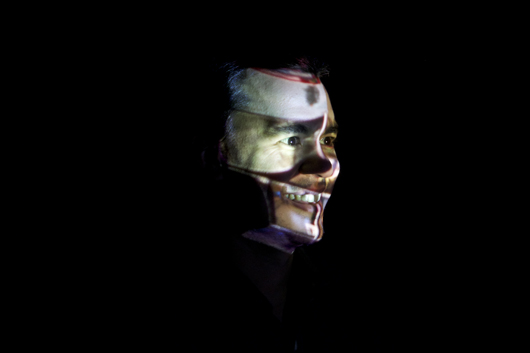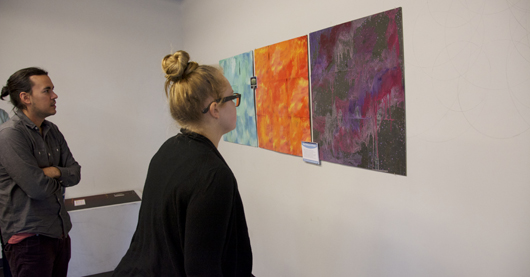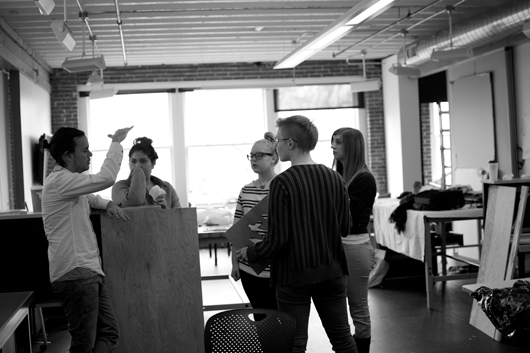
Portland’s Digital Arts Program Brings Rick Silva, Winter 2014
The Digital Arts program in Portland at the School of Architecture and Allied Arts is a unique option for students who elect to spend a fifth year refining the genre and their BFA work. The program gives students an opportunity to connect to the thriving arts scene in Oregon’s largest and most cosmopolitan metropolis and sets the stage for continued connections, exposure, and integration into an arts and culture environment with a global reputation.
Each term, the program invites a faculty member from Eugene or a guest instructor based in Portland to conduct the Portland group of students with a specific curriculum encompassing study and instruction, experience and lecture. For winter 2014, Rick Silva joined the Portland faculty and enlightened the students through a term’s worth of artistic endeavor.
In the world of digital art, Silva holds a place that is new and vividly ground-breaking. He is internationally lauded for his work with the computer screen, his gifs and phenomenal 3-D animations—work that leaves the viewer clamoring for more in a thirsty visually captivating and compelling way. To view Silva’s work is really to have both your intelligence and your cerebral capacity simultaneously provoked. A glance will never do. His work commands a deep, lingering stare—what you see, is not necessarily what you get as images morph, change and play with stills given electronic life by imposed motion and the brilliance of metronome-like regulated repetition. It is a fantastic world Silva creates and it is only by viewing some of his work, that you will get an idea of what was meant when he was called “a recognized pioneer in new Media Art.”
I had an opportunity to interview Silva this winter and he was good enough to provide responses to questions via email. What follows are his responses to a few select questions about his time in Portland and the experience teaching in the Digital Arts program here.
Here is a quick bio to provide some background context:
Rick Silva’s animations, videos, websites, performances, and video games explore landscape, remix and glitch. In his recent project enpleinair.org he is taking his laptop into the wild and creating 3D animations in response to the immediate terrain and elements.
Silva’s art has shown in exhibitions and festivals worldwide, including Transmediale (Germany), Futuresonic (U.K.), and Sonar (Spain). His research has been supported through grants and commissions from places such as Rhizome and The Whitney Museum of American Art. He has performed live multimedia works in London at E:VENT Gallery, Tokyo at The Machida City Museum of Graphic Arts, and throughout North America including the Software Cinema Festival in Houston Texas. Media outlets such as The New York Times, The Guardian, The Huffington Post, and the CBS Evening News have all featured his art. Recently, the author of the bookTransmission Arts: Artists and Airwaves regarded him as “a recognized pioneer in New Media Art.”
Silva received his MFA from the University of Colorado in 2007. He has previously taught at the University of Georgia and the Alberta College of Art + Design. [Source]
SP: How has teaching the Digital Arts program this term effected your work?
RS: One of the two classes I’m teaching this term is a Web Art class. Web Art, or Internet Art, is a scene I’ve been active in for about a decade now. I often teach Internet Art as a small section in other digital art studio classes, but I haven’t had the chance to plan an entire course around it. Student’s lives are often so intertwined with the internet, but very few knew about how artists have used the web as a medium in the last 20 years.
It was a great opportunity to rewind to early 90s Internet Art, to touch on some of today’s varied approaches, and to share some of my own history in the scene as well. Thinking about that class, and the history of Web Art, is working itself into some of my new projects that are web based.
SP: Please comment on working in Portland and with the students in the Portland program…what opportunities are here for them?
RS: The 5th year Portland BFA option is a really unique opportunity for our UO Digital Art undergrads, and it has been good for me to experience it first hand as a professor here this term.
Students have close access to the whole Portland art, music, film, and design communities. They get a whole school year to work intensely on their creative practice, and to get weekly, even daily, feedback on their work from their peers, faculty, and community.
Students also have access to some cutting edge equipment like Formlab printers, Oculus Rifts, sound booths, laser cutters, and more. Having a big final show at The White Box gallery [space] is an awesome opportunity as well.

SP: How have the reviews with the Portland community reviewers contributed to the students’ practice and development of their work and ideas?
RS: They become important markers of progress for the students as the year unfolds. The reviews make the students accountable to an audience outside of our classroom.
SP: You have had an exhibition open during this term at the PSU Anzen gallery: was that recent work? And was it influenced at all by your being in Portland? Has Portland contributed at all to your professional practice? Are there opportunities here that you have been impressed with or have contributed to your work?
RS: Yes, that was recent work. The exhibition at PSU was done in collaboration with an artist run space I’m a member of called Ditch Projects. When Ditch Projects has a members show we don’t usually credit each person’s work, so often each of us takes the opportunity to step outside our styles and try something new.
My work is often situated outdoors, and I hardly ever work with text in my videos, so I used this exhibition opportunity to make a 3D animation that has a a very white gallery scene with rotating white pedestals, and digitally spray painted text that spins around and reveals itself on a loop once a minute.
This work was not really influenced by Portland, more just the parameters and theme of the exhibition. I do often think about place or displacement in my art, and sometimes that comes after I’ve lived or visited somewhere, I’m sure something Portland-esque will find its way into a future project.
SP: What have been some of the highlights of the term in your program for this group of students?
RS: One highlight was an assignment I gave in the Web Art class, where students were asked to create real world objects influenced by internet technology or culture. One student created physical “pop ups” and put them on all the other student’s projects. It was interesting how as we walked around and talked about all the projects one by one, and everyone just ignored the added “pop ups,” exactly how we ignore ads on the internet in real life.
SP: Who have you brought in as guest artists or speakers?
RS: This term we’ve had Jeremy Rotsztain, a local digital artist that focuses on touch interface / software art. Jordan Tate, an artist and professor from Cincinnati. And Krystal South, a Portland artist/writer/designer.
SP: Have you done anything specific to being in Portland—taking or talking to the students about what is here and how they can integrate or be involved with the artistic community?
RS: Yes, on my course calendars I list as many Portland art/design happenings that I can find, and urge them to engage with the local scene.
In discussions, I bring up a lot of Portland artists, designers, galleries, and institutions as examples. It’s great to point to art that is happening in the city right this moment, for example the PSU Ditch Projects show, or the 2014 Portland Biennial.
SP: Any comments you can add about your work (current) directions you are going in, influences you have in your work, or new ideas you are exploring?
RS: I’ve been thinking a lot about bird migration patterns this term. I saw this link from a Portland news station the other day that really resonated with me. It talks about these migrating birds that are being digitally mapped by weather radars during the night.
I’m thinking that will for sure end up in a new project somehow.

Thank you, Rick Silva!
Many thanks to student Dave Braithwaite for the images used in this post.











